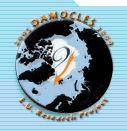Links
Funding/Collaborators
National Science Foundation
Primary funding for the ITP project has been provided by the U.S. National Science Foundation (NSF) Office of Polar Programs (OPP). Prototype development and construction was funded jointly by the NSF Oceanographic Technology and Interdisciplinary Coordination (OTIC) Program and OPP. Ongoing ITP activities are being supported by the Arctic Sciences Division of OPP.
Woods Hole Oceanographic Institution
The engineering design work for the ITP was initiated by the Cecil H. and Ida M. Green Technology Innovation Program (a WHOI-internal program). Supplementary funding to evolve the ITP technology and augment the NSF support of the field program was provided by the James and Ruth P. Clark Arctic research Initiative.
Institute of Ocean Sciences, Fisheries and Oceans, Canada
ITPs have been deployed annually in the Beaufort Gyre/Canada Basin sector of the Arctic since 2004 as part of a collaboration with IOS under the Beaufort Gyre Exploration Project.
US Army Corps of Engineers
Whenever possible, ITPs are deployed together with CRREL Ice Mass Balance Buoys (IMPs) in order to collect simultaneous information about the evolving state of the polar sea ice and upper ocean.
Naval Postgraduate School
Whenever possible, ITPs are deployed together with NPS Autonomous Ocean Flux Buoys (AOFBs) that sample the water properties and turbulent fluxes in the ocean immediately below the supporting ice floe.
Polar Science Center, Applied Physics Laboratory, University of Washington, North Pole Environmental Observatory
Frequently, an ITP is deployed within a collection of instruments on an ice floe (an Ice-Based Observatory) in conjunction with the PSC NPEO program. These systems typically drift through Fram Strait within one year of deployment.

Alfred Wegener Institute for Polar and Marine Research, Germany
Colleagues at the AWI have contributed significantly to the ITP array in the Arctic through instrument acquisitions and deployments as well as engaged in scientific collaborations that utilized ITP data.
European Union; Developing Arctic Modeling and Observing Capabilities for Long-Term Environmental Studies (DAMOCLES)
During the recent International Polar Year (IPY), the DAMOCLES program funded and fielded several ITP systems that contributed significantly to the array during this intensive study period. DAMOCLES investigators have also carried out research based on ITP data.
Arctic and Antarctic Research Institute, Russia
Scientists at AARI have contributed to the ITP array through instrument acquisition as well as supporting field deployments. AARI investigators have also carried out research based on ITP data.
Scottish Marine Institute
Scottish Association for Marine Science, United Kingdom
U.K. scientists working through SAMS have contributed to the ITP array through instrument acquisitions as well as fielding Ice Mass Balance Buoys in association with ITP deployments. U.K. Investigators have also carried out research based on ITP data.
International Arctic Research Center, Nansen and Amundsen Basins Observational System
Through a collaboration with NABOS investigators, ITPs have been deployed during NABOS expeditions to the Arctic. NABOS investigators have also carried out research based on ITP data
EUMETSAT Ocean & Sea Ice Satellite Application Facility
Researchers at EUMETSAT use hourly trajectories from ITPs to validate and monitor their operational Sea Ice Drift products.








